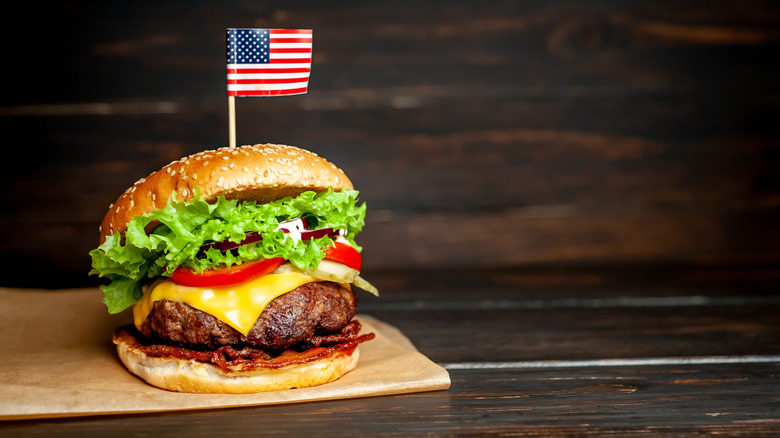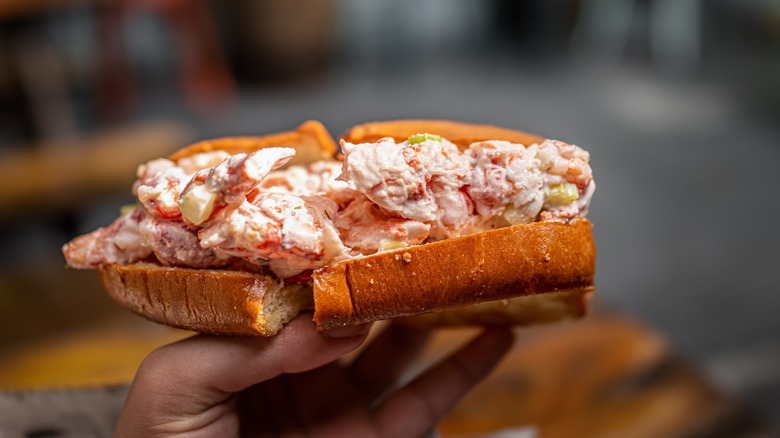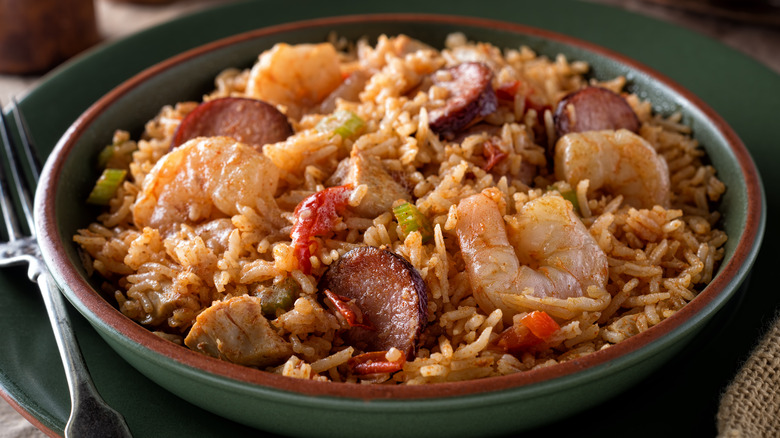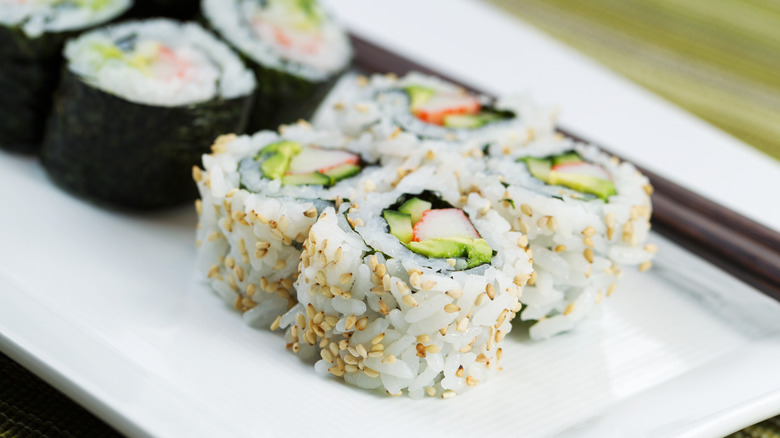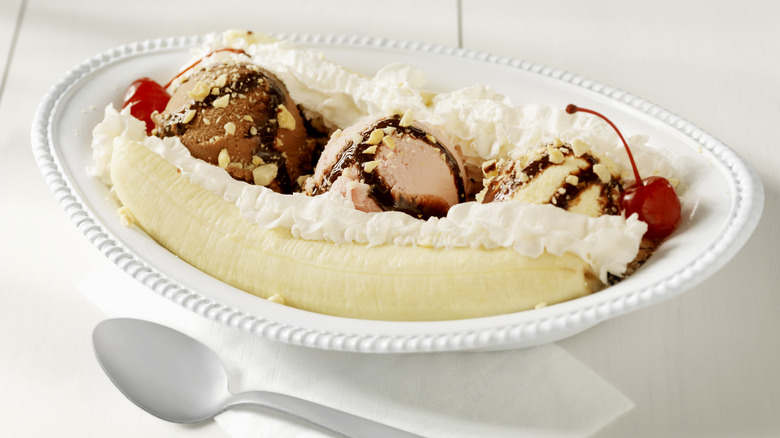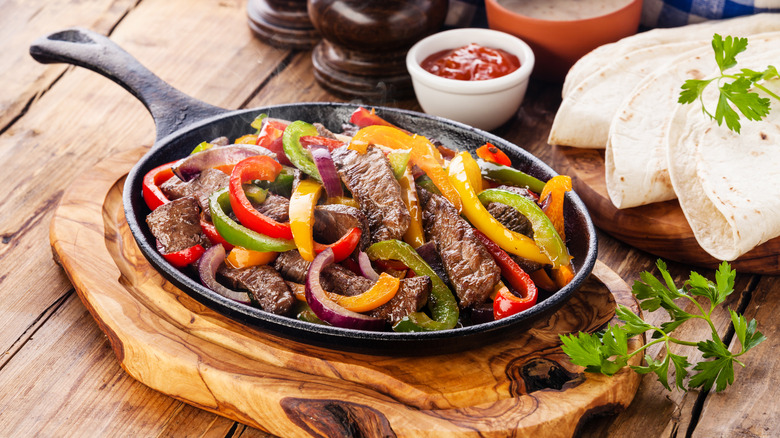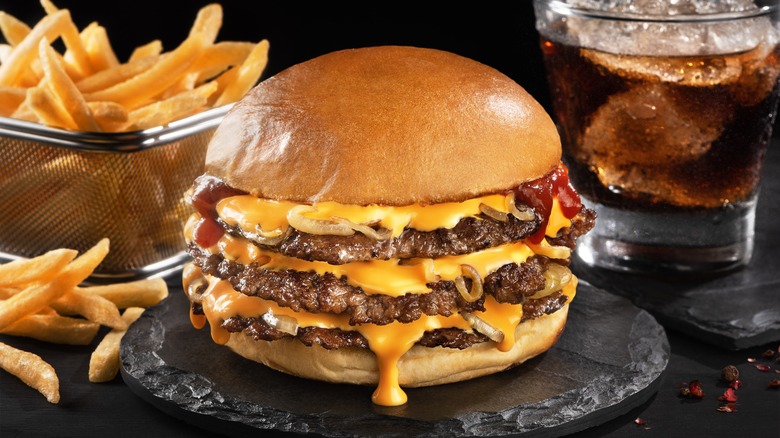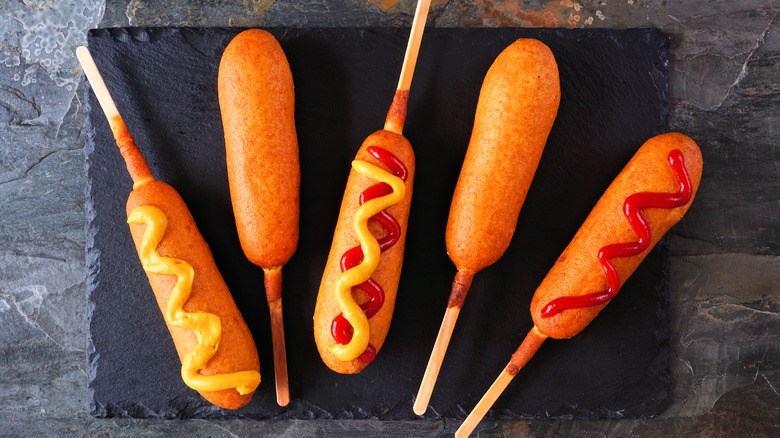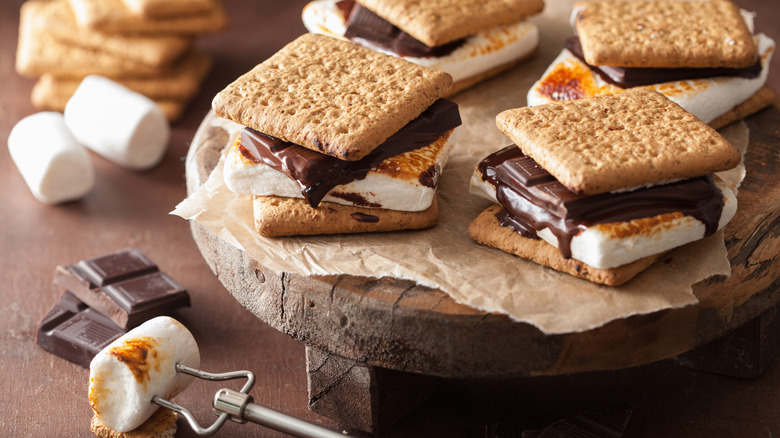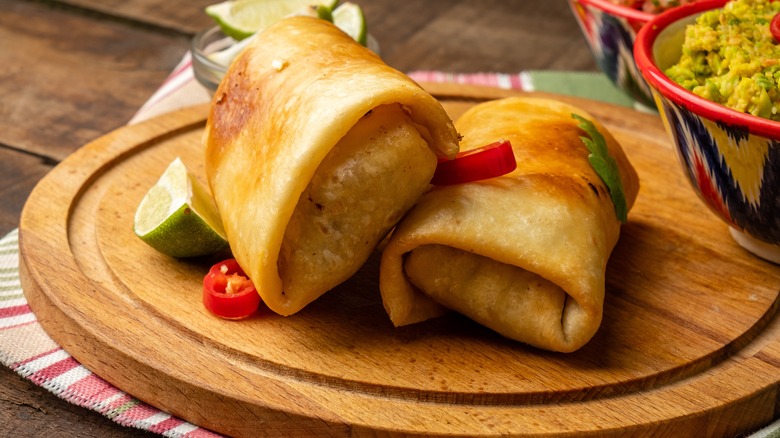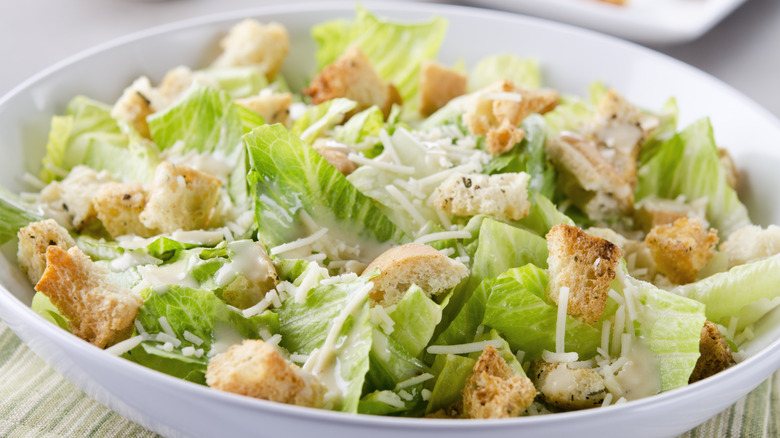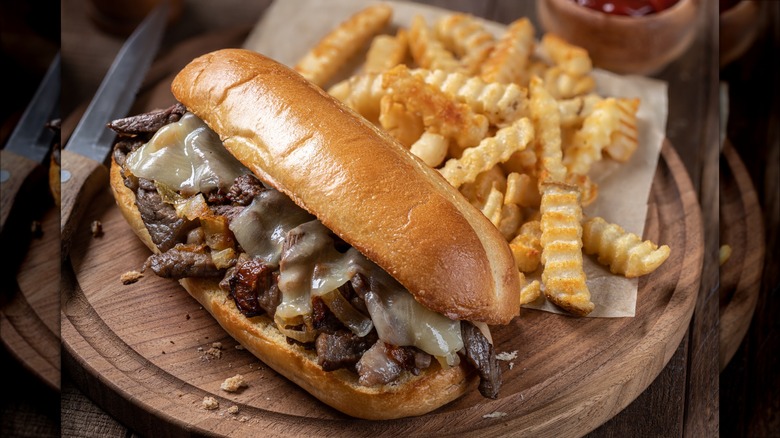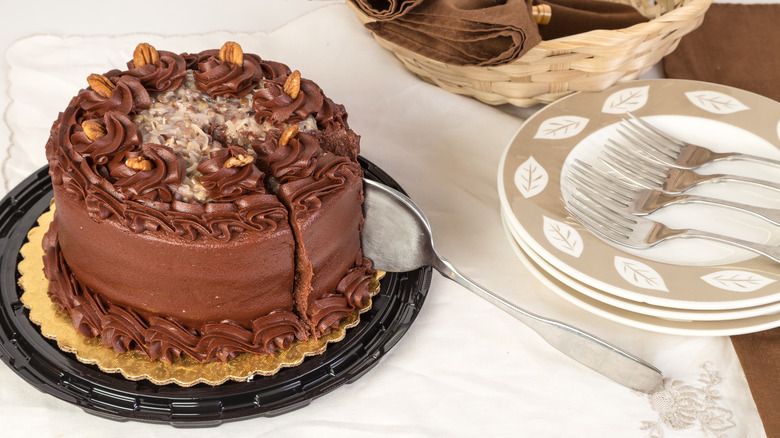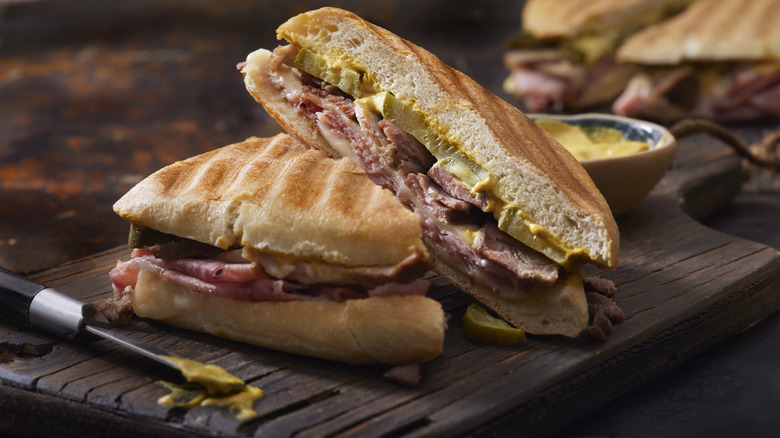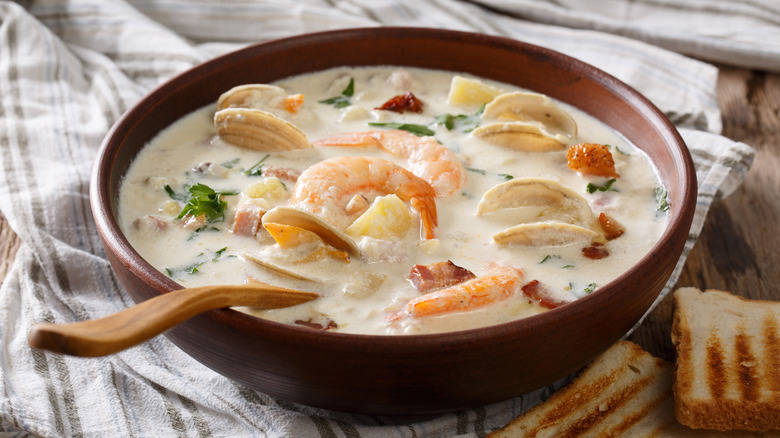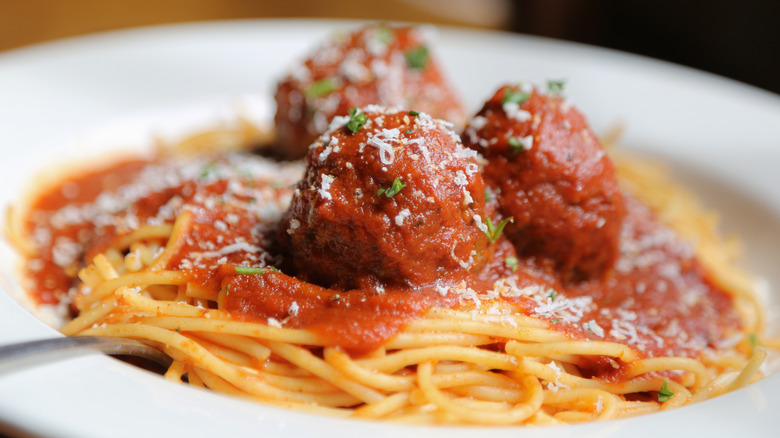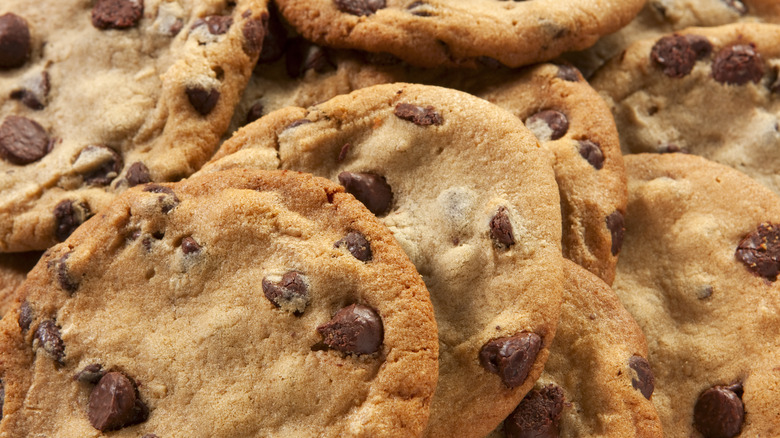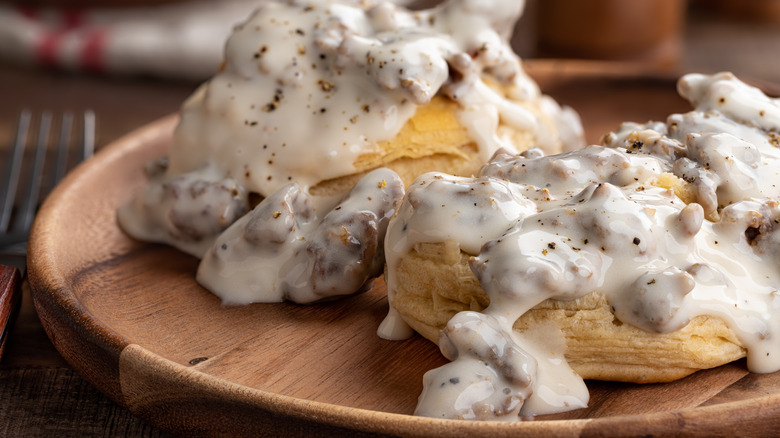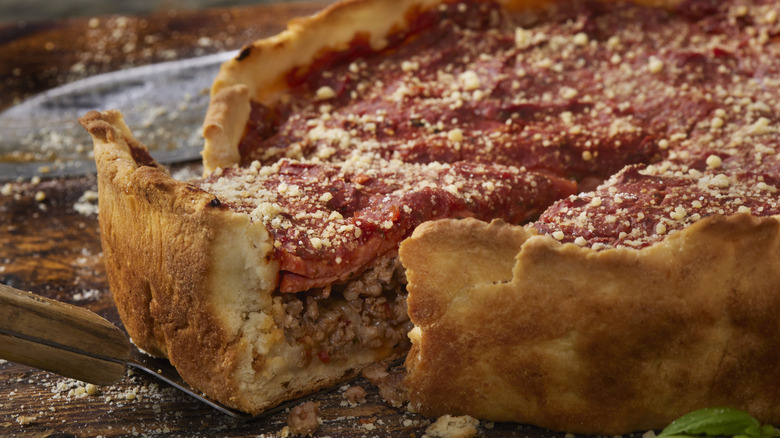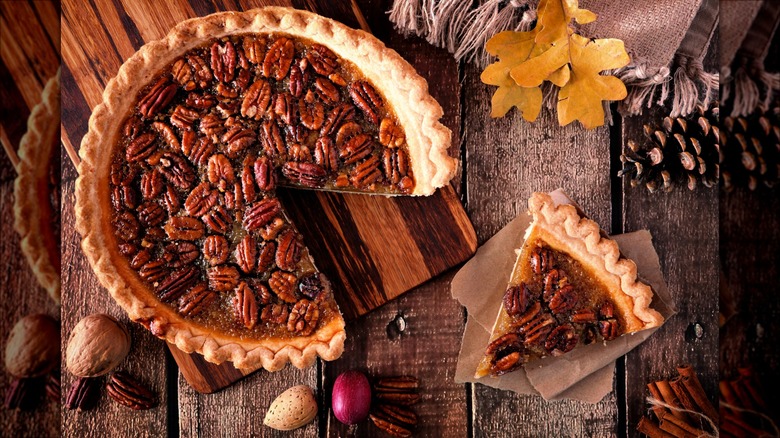20 Foods That Were Invented In America
American cuisine is a blend of culinary traditions from around the world. Between Tex-Mex restaurants and several states with their own Little Italy, the United States is known for fusion foods and spins on the traditional, but it also boasts a rich history of original recipes. In the Southern states, you've got just about anything smothered in country gravy, while on the East Coast and in New England, you'll have your chance to try an authentic lobster roll or clam chowder.
Some dishes, like meatloaf or pot roast, have become quintessentially American despite having long ago originated in different countries. Other favorites, like burgers, deep dish pizza, and pecan pie, are true staples that found their way to our stomachs on American tables first. With cookbooks full of comforting, hearty dishes and classic desserts, the United States has given rise to a diverse range of delicious favorites. Here, we'll explore some foods that are rooted in American culture.
Lobster rolls
An iconic American seafood dish primarily found in the Northeast, lobster rolls are typically composed of fresh lobster meat tucked inside a split-top, buttered hot dog bun and dressed with a blend of mayonnaise, melted butter, lemon juice, and seasonings.
Originating in New England, the storied history of the famous lobster roll remains a topic of debate — some say it was Harry Perry, the owner of Perry's restaurant in Milford, Connecticut while others claim it was in Maine that the trend began — but the sandwiches gained popularity in the 1970s. Maine-style lobster rolls usually feature chilled lobster meat, allowing its sweet flavor to shine through, with minimal mayo and seasonings. In contrast, Connecticut-style rolls prefer warm lobster chunks bathed in butter, and they serve them without the mayonnaise.
Jambalaya
It's said that Spanish settlers brought along the basics for jambalaya with them to New Orleans, where the dish is now perhaps most known. While it's challenging to pinpoint the exact origins of this popular dish, it is widely acknowledged that jambalaya has been profoundly shaped by Spanish, African, and French culinary traditions. The main components of jambalaya — rice, meat (often a combination of pork, chicken, and sausage), onions, peppers, and bold, spicy seasonings — reflect the culinary diversity of Louisiana.
Over time, jambalaya has become a symbol of the rich culinary heritage of Louisiana, rather than being solely attributed to Spanish settlers. Still, the Spanish practice of making paella, a rice dish typically flavored with saffron and combined with various meats and seafood, had a major influence on the American dish. Moreover, the West African dish, jollof rice, could've led to today's Creole version, also known as red jambalaya.
California roll
Most agree that the California roll originated right in California – Los Angeles, to be exact. It was there that a sushi chef, Ichiro Mashita, combined the few elements that make up the popular roll — cucumber, imitation crab, and avocado — while looking for a substitute for tuna. This was back in the 1960s in LA's Little Tokyo region. From there, the California roll only gained more attention as a fusion of both Japanese and Western cuisine.
Some argue that the first California roll actually came from Canada. As Business Insider tells it, a Canadian chef, Hidekazu Tojo, lays claim to the sushi roll, saying it came from his restaurant in Vancouver back in 1971. In the interview, Tojo says he tried to trademark his version of the California roll, which consists of fresh crab, avocado, egg, and spinach, but was unsuccessful because Mashita's roll was already branded with the name. Instead, the Canadian version, which differs quite a bit, was originally called the Inside Out roll and now is simply called the Tojo roll.
Banana split
Depending on where you go for the Banana Split Festival, you'll hear different beginnings for the infamous dessert. In the historical debate behind the origins of the banana split, some say it was 23-year-old David Strickler from Latrobe, Pennsylvania who first debuted the dessert in 1904. Others say it was Ernest R. Hazard who came up with the dessert in 1907 at his restaurant in Wilmington, Ohio. Both states host a Banana Split Festival commemorating the treat.
Strickler's version uses a cut banana topped with vanilla, chocolate, and strawberry ice cream and finished with syrup, whipped cream, chopped nuts, and a cherry on top. Hazard's version has the same base of a split banana and scoops of the three classic ice cream flavors, but is garnished with chocolate syrup, strawberries, pineapple, chopped nuts, and whipped cream. While the differences between the two desserts are infinitesimal, neither state is willing to let go of its stake on the dish.
Fajitas
Authentically Tex-Mex, fajitas were first invented around the 1930s along the Rio Grande Valley of Southern Texas, where the borders of Texas and Mexico meet. Initially, fajitas came about as a smart way to utilize tougher cuts of beef; in particular, skirt steak. While other variations exist, with chicken, seafood, or pork instead, the original fajitas were always made with skirt steak on a sizzling skillet. The other ingredients in the tortilla — onions, peppers, and garnishings like cheese, sour cream, and guacamole — have remained largely the same.
Since fajitas became popular, other cooks in Texas cities put their own spin on the dish and began serving them in restaurants across the state. In the late 1960s, Sonny Falcon sold his skirt steak fajitas at an event in Kyle, Texas, where they became so popular that he became known as The Fajita King, according to What's Cooking America. Then, a Mexican-American chef, Ninfa Rodriguez Laurenzo, sold her take on the recipe at her restaurant, calling them "tacos al carbon" before later changing the dish's name to fajitas.
Hamburger
Several states claim to have been the inventor of one of America's most infamous dishes, but while the true origins of the hamburger are hazy, it is undoubtedly American. In a thorough investigation by The Washington Post, references to hamburgers were found in newspapers from a handful of states, but many lacked enough evidence to prove they were truly the first. Food & Wine takes the origins back even further, to first-century Rome's minced meat dishes and 13th-century Mongols, who toted around thick cuts of tenderized beef on their long journeys.
What is certain is that the hamburgers we know today — ground beef between two buns with veggies and condiments — were present at the St. Louis World's Fair in 1904, where several other popular American foods first received significant recognition. At the fair, Fletcher Davis from Athens, Texas, sold the hamburgers after creating the idea for the sandwich in the 1880s. He is often credited as being the primary inventor of the hamburger, despite there being so many other cases of sandwiches that resemble the burger.
Corn dogs
A corn dog: a cornmeal-battered hot dog deep-fried on a stick. Simple enough, right? Until you get down to its unexpectedly mysterious origins. Let's take it back to 1924 when Francis G. Matson filed a patent for the corn dog's design. The only thing missing was the stick. So in 1929, Stanley S. Jenkins filed another patent for an invention that involved a stick for deep-frying.
This means we're getting closer, but then we jump to Oregon in 1939, where the Boyington family sold their version, called Pronto Pups. They adamantly refused the name "corn dog" (otherwise known as the "C-D word"). Still, they weren't quite the food we know today. The Boyingtons' batter consisted of flour, whereas a corn dog relies on cornmeal for its traditional batter.
Then you've got Ed Waldmire Jr., who was given a corn dog in Muskogee, Oklahoma, and created his own version, the Cozy Dog, in 1946. He served them at his Lake Springfield beach house and at the Illinois State Fair that same year. While the corn dog's true origins remain unclear, it's apparent that the iconic food evolved as it passed through the hands of several different Americans, becoming what we know and love today.
S'mores
Around campfires in America, s'mores are made regularly. This classic, gooey dessert is made of three simple ingredients: marshmallows, graham crackers, and a chocolate bar. It's been a staple treat for a while, too — we found the first ever s'mores recipe in a 1927 Girl Scout handbook with a troop leader named Loretta Scoot Crew often getting the credit. Just as we know it today, the original s'more (meaning "some more") involved taking a fire-roasted marshmallow and sandwiching it between two graham crackers along with a piece of a chocolate bar.
For as long as it's been around, it's been in sandwich form. Now, the basic concept has remained the same, but there are countless variations and creative twists on this campfire treat, including s'mores-flavored desserts like ice cream, cookies, and even coffee beverages. Within the last few years, the Girl Scouts even debuted a s'mores-style cookie to back up its delicious history.
Chimichanga
The exact origin of chimichangas is a matter of some debate, but they are believed to have originated in the southwestern United States, particularly in Tucson, Arizona. Instead of being called Tex-Mex, which alludes to food that's a fusion of Texan and Mexican, Arizona calls its fusion food Sonoran-style, referring to when Arizona was part of Sonora, Mexico.
As the legend goes, Monica Flin was cooking in her Tucson restaurant, El Charro Cafe, in 1922 and accidentally tossed a burrito into the deep-fryer (via What's Cooking America). Children were nearby, and when she swore in frustration, she exclaimed "chimichanga," which translates to something like "thingamajig" or "whatchamacallit." In essence, a chimichanga is a fried burrito, so the name stuck along with the mistake.
Caesar salad
Traditionally, Caesar salad is a combination of romaine lettuce, croutons, Parmesan cheese, and a distinctive Caesar dressing. It's believed to have been created by an Italian immigrant named Caesar Cardini at his Tijuanan restaurant in the 1920s. According to BBC, Cardini immigrated to America in the 1910s, where he opened restaurants in both Sacramento and San Diego, in addition to his restaurant in Tijuana. But is the salad American? Kind of!
A big reason why this salad is considered of American origin is because oftentimes, American celebrities traveled across the border to Tijuana during the Prohibition Era, where they could consume alcohol that was otherwise banned. Many stars got their first taste of the salad at Caesar's, and since he also operated US-based restaurants, the lines got a little blurred as far as the true origin. By the time the Cardini family moved from Tijuana to LA, they filed a patent for the infamous Caesar dressing in 1948. Because of the resounding success of the salad and its dressing counterpart, Cardini is credited with the invention in both Mexico and America.
Philly cheesesteak
Native to Philiadelphia, cheesesteaks are a staple of the city. Philly cheesesteaks come from Pat Olivieri, who invented the sandwich back in 1930 at his South Philly restaurant, Pat's King of Steaks. As Philidelphia Magazine describes the tale, Pat began with a hot dog stand and got creative with the meat that would go in the bun. By using meat scraps instead of a wiener, the sandwich got its start.
Later, cheese was added — Pat's great-nephew, Frank Olivieri, says that one of their employees, Joe, got the idea to put cheese on the steak sandwich. Thus, the cheesesteak was official. Since then, other restaurants throughout Philadelphia got the same idea, and the sandwich swiftly took over the city.
German chocolate cake
Contrary to what its name suggests, German chocolate cake was concocted by a Texan homemaker. In 1957, a Dallas newspaper published the recipe from Mrs. George Calay. The dessert's name actually comes from the kind of chocolate used to make the cake, which also isn't German — it's the surname of the chocolatier, Sam German, who created the baking chocolate in the 1800s. His chocolate became Baker's German's Sweet Chocolate, which you can still buy in stores today.
In traditional recipes, German chocolate cake is comprised of rich, moist layers of chocolate cake and a coconut-pecan frosting. Other versions incorporate German chocolate but cover it with different kinds of frosting or layer it with decadent fillings.
Cuban sandwich
When Cuban immigrants settled in Florida back in the 1830s, they brought their culinary traditions along with them. Both Miami and Tampa have long claimed the Cuban sandwich as their own, but according to The Local Palate, the sandwich was featured in The Tampa Tribune in 1906, long before Miami could've come up with it. Serious about their ownership, Tampa took the extra step in 2012 and branded the "Historic Tampa Cuban Sandwich" as the city's official signature sandwich.
No matter which Florida city is the true birthplace, the sandwich has become an American classic. This complex, meaty sandwich is built with marinated, roast pork, sweet ham, and Genoa salami and dressed with Swiss cheese, pickles, and mustard.
Clam chowder
Clam chowder, a creamy soup with clams or other seafood, potatoes, onions, and pork or bacon, has roots in early European settlement in New England. How it's made depends on where you are: In some New England states, you'll get a stew or soup made with a tomato broth, called Manhattan clam chowder, and in others, it'll be a cream or milk base, which is traditional New England clam chowder.
While the exact origins are hard to pinpoint, New England chowder was seen in a Boston publication in 1751 and was well-loved by the 1850s, and the first recipe for Manhattan clam chowder appeared in 1934. Its name is less associated with New York than it is with the New England states that incorporate tomatoes instead of cream, like Rhode Island and Connecticut.
Spaghetti and meatballs
You're not likely to have spaghetti and meatballs as you know it if you visit Italy, and that's because it was Italian immigrants who came to New York between the years 1880 and 1920 that invented the comfort food. They brought their recipe for authentic Italian meatballs, which differs from meatballs found in other cultures.
Traditionally, Italian meatballs call for beef, lamb, sausage, or turkey with equal parts of soaked bread, sometimes vegetables such as onions, and you absolutely cannot forget herbs and spices. As far as the sauce, it's always tomato-based but is often marinara. Because the ingredients for the meat and sauce were significantly cheaper than they were in Italy, the Italian-American dish was easier to assemble in America.
Chocolate chip cookies
Chocolate chip cookies are a beloved, classic treat, and we have Toll House Inn to thank for them. As the story goes, a woman from Massachusetts, Ruth Wakefield, popularized the cookies. Some say the dessert was created by happenstance when she forgot the nuts and decided to use chocolate. Another myth is that she meant to melt the chocolate but instead threw it in at the last minute in chip form.
Then she gave her recipe to Toll House, where she worked in the late 1930s. Later, in 1939, she granted Nestle the rights to her recipe and the Toll House name. Her original recipe is still printed on Nestle chocolate chip bags today.
Biscuits and gravy
A true Southern American staple, biscuits and gravy first came about during the Revolutionary War. Most pinpoint their history as beginning in the 1800s in Southern Appalachia. Originally, biscuits were hard. Once baking soda and baking powder came around, one or the other was combined with flour to create a quick biscuit that evolved into the fluffy ones we love today.
Likewise, gravy was a way to be resourceful during the War because it only took a few ingredients — or those left over, like sausage drippings — to whip up the creamy sauce. Even today, biscuits and gravy are a simple and affordable dish whether you make it yourself or buy it in a diner.
Deep dish pizza
Chicago-style deep dish pizza may be popular throughout America now, but it got its start in the Windy City. When Neapolitan immigrants traveled to Chicago at the turn of the 20th century, they brought along culinary customs, like pizza! What makes a Chicago-style pizza is its depth — it's called "deep dish" for a reason.
In 1943, two Italian-American chefs, Ike Sewell and Ric Riccardo, came together to create an American version of their favorite Neapolitan pizza pie. They baked it in a pan, and the tall pie was nothing like the flat pizzas many had seen thus far. Another big difference is how it's built: For a perfect deep dish pizza, the toppings should be inverted with the cheese on the bottom to prevent burning, and the sauce, meats, and any veggies packed on top.
Pecan pie
There isn't just one person who is credited with inventing pecan pie, but rather several influences on the dessert. One popular theory regarding the pie's origins suggests that French immigrants in New Orleans got pecans from Native Americans during the 18th century, leading to its creation.
But some of the earliest recipes for pecan pie came out of Texas cookbooks in the 1870s and 1880s. Then, when Karo corn syrup was invented, which came from their company based out of New York and Chicago, they marketed recipes for the pie on bottles during the 1930s. That's primarily how pecan pie became an iconic Southern staple, with homemakers across the U.S. perfecting their personal recipes.
Buffalo wings
If you ask New Yorkers, Buffalo wings were birthed in Buffalo. As the History Channel tells it, Frank and Teressa Bellissimo are often credited with inventing the saucy wings at their business, Anchor Bar. They opened their business around the 1960s but gained popularity for the wings by the 1980s. But just around the corner, John Young had his own business since the 1960s, Wings and Things, that had also been serving sauce-covered chicken wings.
His sauce, inspired in Chicago, was sometimes called "mambo" or "mombo" before it was ever coined as "buffalo." He sold wings covered in it at his Washington, D.C., restaurant before serving a different rendition at his Buffalo location. Some think his sauce became buffalo sauce, which leads to much of the confusion of the true origins. Nevertheless, the spicy, bold wings undeniably hail from America — and likely Buffalo itself.
